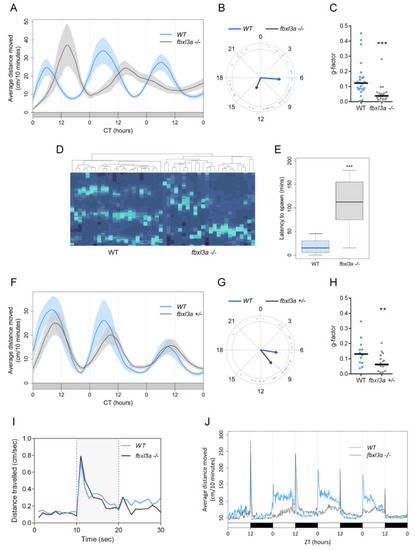Figure 4
- ID
- ZDB-FIG-220302-202
- Publication
- Confino et al., 2022 - A Zebrafish Model for a Rare Genetic Disease Reveals a Conserved Role for FBXL3 in the Circadian Clock System
- Other Figures
- All Figure Page
- Back to All Figure Page
|
FBXL3a deficiency affects locomotor activity rhythms in zebrafish larvae under different lighting conditions. (A) Locomotor activity analysis of 6?8 days post-fertilization (dpf) WT and fbxl3a?/? larvae under constant dim light (DimDim) after entrainment to 3 light/dark (LD) cycles, followed by 2 light/dim light (LDim) cycles. The average distance travelled (cm/10 min) is plotted on the y-axis; circadian time (CT, hours) is plotted on the x-axis. Error bars represent ± SE (n = 24). (B) Phase difference expressed as activity peak with respect to CT0, indicating a 7.2 h phase-delay for the fbxl3a mutants (p < 0.001, Watson?Williams test). Arrows represent the mean value of each genotype; dots represent individual values; and arrow length is inversely related to the variation within genotype. (C) G-factor distribution of WT and fbxl3a?/? larvae under DimDim. Each dot represents the G-factor score of an individual larva; the median value for each genotype is indicated by a black horizontal line. A significant difference in G-factor distribution was determined between the two genotypes (*** p < 0.001, Wilcoxon test). (D) Clustering analysis represented by a heat map emphasizes the disordered rhythms of locomotor activity of fbxl3a?/? larvae. Right cluster, fbxl3a?/? larvae (n = 24); left cluster, WT siblings (n = 24). Significant clustering was determined between the two genotypes using Wilcoxon test (p < 0.001). (E) Delayed spawning time of adult fbxl3a?/? fish under LD conditions compared with their WT siblings (*** p < 0.001, Wilcoxon test, n = 16). (F) Locomotor activity analysis of 6?8 dpf WT (n = 12) and heterozygous (fbxl3a+/?, n = 18) larvae under DimDim after entrainment to three LD cycles, followed by 2 LDim cycles. The average distance travelled (cm/10 min) is plotted on the y-axis; CT (hours) is plotted on the x-axis. Error bars represent ± SE. (G) Phase difference expressed as activity peak with respect to CT0, indicating a 2.83 h difference between genotypes. Arrows represent the mean value of each genotype; dots represent individual values; and arrow length inversely represents variation within genotype. (H) G-factor distribution of WT and fbxl3a+/? larvae under DimDim. Each dot represents the G-factor score of an individual larva; the median value for each genotype is depicted as a black horizontal line. A significant difference in G-factor distribution was determined between the two genotypes (** p < 0.01, Wilcoxon test). (I) Larval mobility is not affected by fbxl3a LOF. On the 6th dpf, larvae (n = 24) were placed in the DanioVision tracking system. After acclimation to 2 h of light, three 10 s dark flashes, separated by 30 min of light, were applied. The activity of the larvae before, during (grey-shaded) and after the dark flashes was analyzed. No difference was observed between two genotypes, indicating that LOF of fbxl3a does not affect larval mobility. (J) Blunted locomotor activity rhythms of fbxl3a?/? larvae under LD cycles and their lack of response to dark-to-light transitions. The average distance travelled (cm/10 min) is plotted on the y-axis; zeitgeber time (ZT, hours) is plotted on the x-axis. Error bars represent ± SE (n = 24). White and black bars indicate light and dark conditions, respectively. |
| Fish: | |
|---|---|
| Conditions: | |
| Observed In: | |
| Stage Range: | Days 7-13 to Adult |

